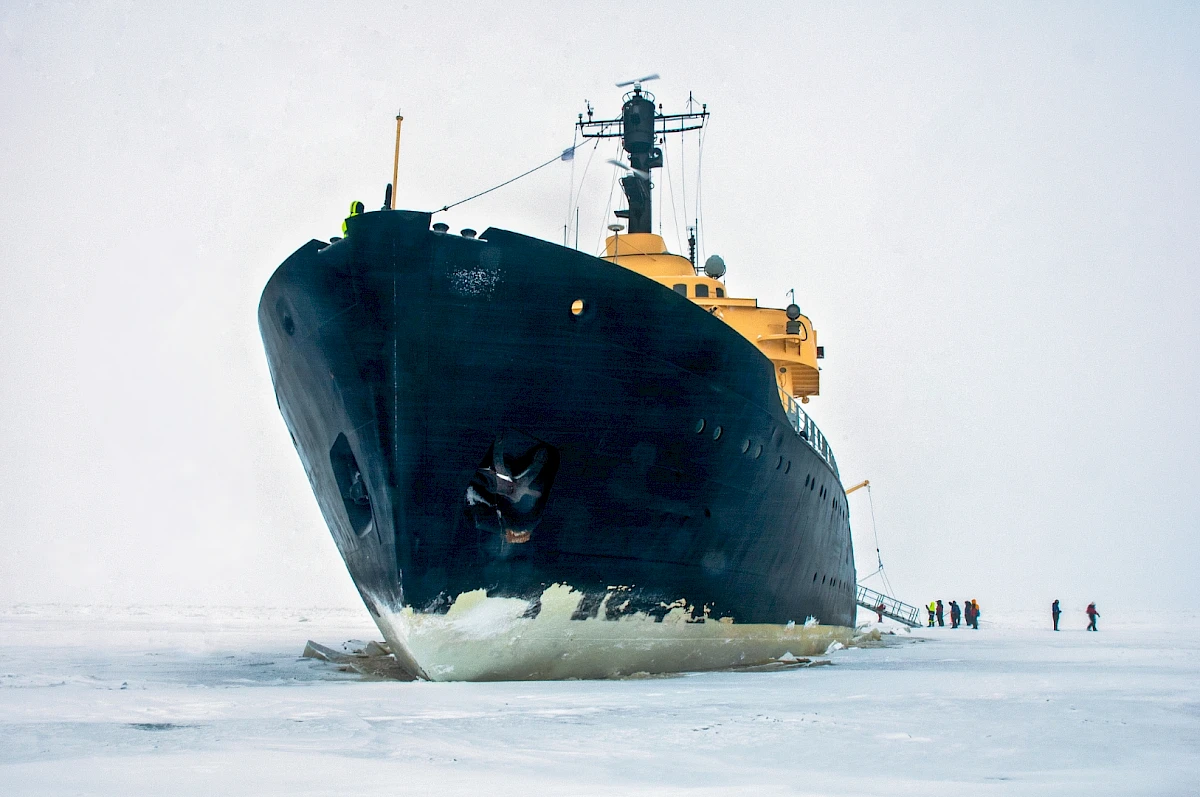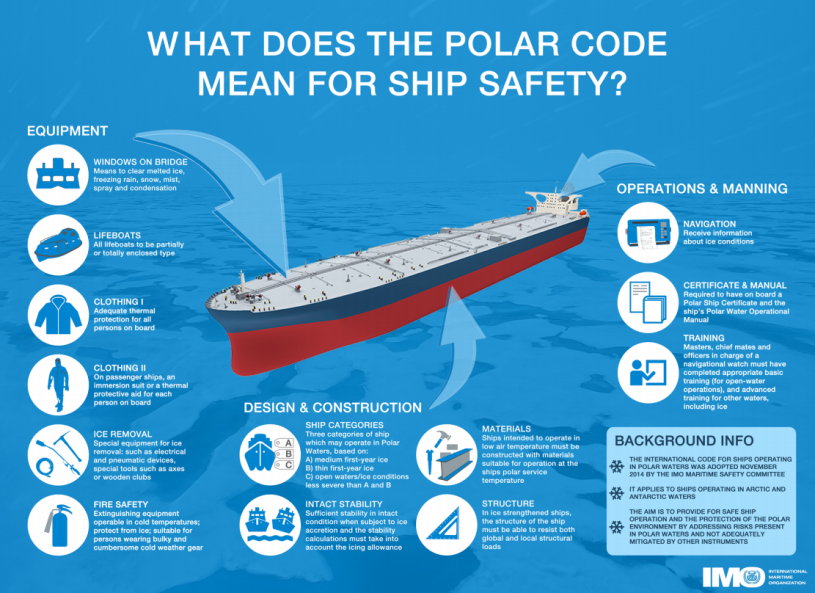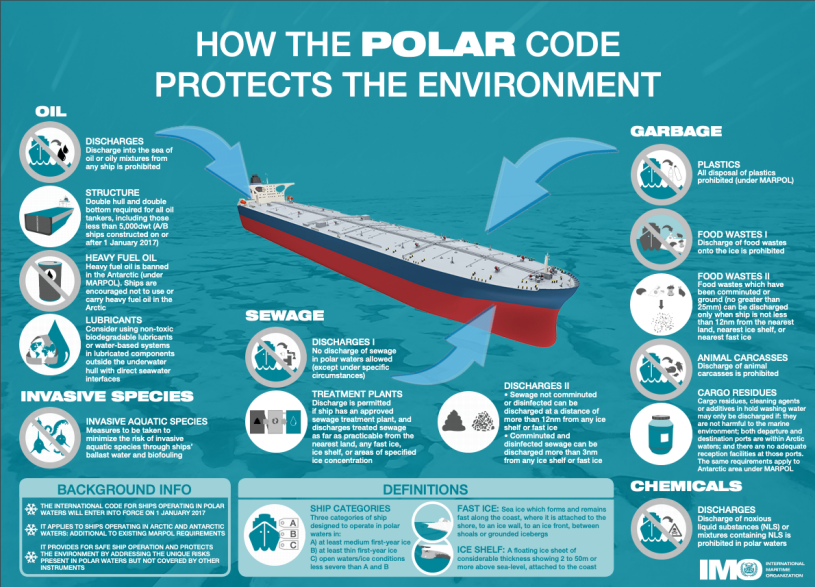Chapter 1: General (Part IA)
Chapter summary:
Chapter 1 provides the overall structure and framework for Part I of the Polar Code, as well as additional definitions not noted in the introduction, the requirements for the issuance of Polar Ship Certificates and surveys, and the general criteria for determining ship performance standards and operational assessments. These are set out in the text of Chapter 1 below, and in the Part 1B Additional Guidance.

Submissions
ABS is a leading international classification organization devoted to promoting the security of life and property and preserving the natural environment through the development and verification of standards for the design, construction and operational maintenance of marine and offshore assets.
ABS was heavily involved with and actively participated in the development of the Polar Code. Being so close to the code’s development enabled ABS to create and publish one of the first guidelines for industry a year before the Code came into force: IMO Polar Code Advisory.
To disseminate its knowledge, ABS offers training to ship owners/operators on the IMO Polar Code. This training provides owners an understanding of the requirements of the Code, how to manage its goal based standards structure, and how to effectively progress through the process up to and including issuance of the Polar Ship Certificate.
A key aspect of the Polar Code is contained in Chapter 1 Paragraph 1.5 – Operational Assessment, one of the cornerstones to the Polar Code’s application. An ABS Facilitated Operational Assessment, is a service offered by ABS where a formal HAZID is performed, climatic conditions and the ship’s capabilities and the Code’s requirements are closely examined to determine the required risk control measures. The outcomes of this assessment form the foundation to the ship specific Polar Waters Operational Manual.
ABS Advisory Services has prepared a full Polar Code support offering for industry. Please contact us at JBond@eagle.org or DOldford@eagle.org
AINA is a partner in a 4 year project - GENICE- which is to address the need to develop preparedness and response strategies for fuel spills in Arctic waters. The project brings together a broadly interdisciplinary and multi-sectoral team to combine cutting-edge genomics, analytical chemistry, and sea-ice geophysics with economic, policy and end-user expertise to focus on the role of and potential for bioremediation of fuel spills in the Arctic marine environment. The overarching objectives of the project are to generate baseline microbial genomics data for the Hudson Bay Corridor, conduct a series of bioremediation viability case studies, develop recommendations on technology-based emergency spill response strategies, and define best practices for knowledge sharing, capacity building for spill-response, and policy development; each of these objectives is informed by genomics.
This work is relevant to the Polar Code Part IIA: Pollution Prevention Measures Chapter 1. Prevention of Pollution by Oil in particular and outcomes could potentially be used to support decision making with respect to response to incidents and counter-pollution activities such as oil pollution combating strategies, spill response, pollution prevention equipment for ships, and shipping route designation.
The IHO, as an Observer organization at the IMO and its chief advisor on nautical charting issues, has contributed to the safety considerations of the Polar Code, related specifically to the generally unsatisfactory state of the underlying hydrographic surveys from which existing nautical charts in the polar regions are derived.
The IHO input has been based on the work of the two hydrographic Commissions that cover the polar regions - the Arctic Regional Hydrographic Commission (ARHC) and the IHO Hydrographic Commission on Antarctica (HCA). Each Commission provides a framework for cooperation and coordination between the various countries that produce nautical charts of polar waters.
- IHO Hydrographic Dictionary (IHO Publication S-32)
- Status of Hydrographic Surveying and Charting Worldwide (IHO Publication C-55) (5 November 2020) (provides base data for governments and supporting international organizations as they consider the best means by which to implement responsibilities set out in Chapter V, Regulation 9, of the Safety of Life at Sea (SOLAS) Convention)
- Joint IHO/IMO/WMO Manual on Maritime Safety Information (MSI) (IHO Publication No. 53) (January 2016)
- Facts About Electronic Charts and Carriage Requirements (IHO Publication S-66) (January 2018)
- The Need for National Hydrographic Services (IHO Publication M-2) (June 2018)
- Caution Required When Using Nautical Charts of Arctic Waters (ARHC Notice) (28 June 2017)
- International Bathymetric Chart of the Arctic Ocean (IBCAO) (Version 4.0, July 2020) (The goal of the IBCAO initiative is to develop a digital database that contains all available bathymetric data north of 64° North, for use by mapmakers, researchers, institutions, and others whose work requires a detailed and accurate knowledge of the depth and the shape of the Arctic seabed.)
- Mariners' Guide to Accuracy of Depth Information in Electronic Navigational Charts (ENC) (IHO S-67) (October 2020)
The following explanatory graphics and videos are replicated from the IMO website. Further important information is detailed on the Polar Code section of IMO's website, including information on the second phase of the Polar Code.


Guidence on Surveys:
- Note IMO Circular 16 December 2016 (MSC.1/Circ.1562)
Guidance on methodologies for assessing operational capabilities and limitations in ice
- Note IMO Circular 6 June 2016 (MSC.1/Circ.1519)
Interim guidelines on life-saving appliances and arrangements for ships operating in polar waters.
- Note IMO Circular 26 June 2019 (MSC.1/Circ.1614)
Training of Seafarers
Resolution MSC.416(97), adopted on 25 November 2016, containing amendments to the STCW Convention, 1978 , including amended regulation I/1.1 adding definitions of “Polar code” and “Polar waters”, amended regulation I/11 requiring continued seagoing service for masters and officers for the continued professional competence for ships operating in polar waters, amendments to chapter V of the STCW Convention (Regulation V/4 on “Mandatory minimum requirements for the training and qualifications of masters and deck officers on ships operating in polar waters”).
This led to the development of IMO model course on Basic and Advanced Training for ships operating in polar waters (see image).
Further information on Polar Code (second phase):
- Resolution A.1137(31), adopted on 16 January 2020, Interim safety measures for ships not certified under the SOLAS Convention operating in polar waters
- Guidance for navigation and communication equipment intended for use on ships operating in polar waters (MSC.1/Circ.1612, June 2019). See Maritime Safety Committee (MSC), 101 session, 5-14 June 2019.
Hyperlink 1: The Polar Code by Lloyds
Lloyd's provides information and assistance for users to comply with the Polar Code. Lloyd's interactive toolkit allows users to work through the Code on their own terms and download Lloyd's register free guidance, templates and examples to help understand and meet compliance needs.
Hyperlink 2: Lloyd's Polar Code Resources
Lloyd's also provides guidance documents on; the Operational Assessment, setting operational limitations (limitation wording), determining the Operating Envelope and LR’s How to use POLARIS.
Hyperlink 3: The Polar Code: A Regulatory Interpretation Guide
This document provides Lloyd's Register guidance on all aspects of the Polar Code (chapter by chapter). For Chapter 1, see the LR Regulatory Guide pages 21 to 26.
Lloyd's Register website.
Hyperlink 1: Northern Sea Route – Best practices and Challenges (2017)
For Chapter 1, see pages 1-2.
Hyperlink 2: Offshore Vessel Operations In Ice and or Severe Sub Zero Temperatures in Artic and Sub Artic regions (2014).
The purpose of this paper is to provide guidance to operators and charterers of offshore support vessels employed for use in areas impacted by ice or severe sub-zero temperatures with the aim of encouraging high standards of safety and environmental protection for those operating in Arctic and Sub-Arctic regions.
Hyperlink 1: https://wmo.int
WMO provides information for integrating weather, climate and hydrological data, environmental information and weather-climate predictive tools in the Arctic region, for example through its World Weather Watch (WWW), the Marine Meteorological and Oceanographic Services, the Global Cryosphere Watch and other components of the WMO Integrated Global Observing System (WIGOS), WMO Information System (WIS), and WMO Integrated Processing and Prediction System (WIPPS), as well as its World Climate and Weather Research Programmes (WCRP and WWRP). This is the general link to the WMO's public website.
Hyperlink 2: https://globalcryospherewatch.org/
The World Meteorological Organization's Global Cryosphere Watch (GCW) is an international mechanism for supporting all key cryospheric in-situ and remote sensing observations. To meet the needs of WMO Members and partners in delivering services to users, the media, public, decision and policy makers, GCW provides authoritative, clear, and useable data, information, and analyses on the past, current and future state of the cryosphere.
Hyperlink 3: https://www.ocean-ops.org/
WMO has various in situ observation programmes in polar waters.
The joint WMO-IOC Data Buoy Cooperation Panel (DBCP) established two action groups for the polar regions, the International Arctic Buoy Programme (IABP, 1991) and International Buoy Programme for Antarctic Buoys (IPAB, 1994).
ABP focuses on Arctic Ocean and its marginal seas, excepting Exclusive Economic Zones, with expected resolution of 250km×25okm. It aims to provide meteorological and oceanographic data for real-time operational requirements and research purposes including support to the World Climate Research Programme (WCRP) and the World Weather Watch (WWW) Programme. As of May 2024, there were about 180 buoys operational. More details of IABP data, see http://iabp.apl.uw.edu/
IPAB (jointly WCRP/SCAR) investigates south of 55°S and that region of the Southern Ocean and Antarctic marginal seas within the maximum seasonal sea-ice extent, in 500km×500km grids. It is designed to provide meteorological and oceanographic data for real-time operational requirements and research purposes. In June 2020, there were 65 operational buoys, leaving most of Southern Ocean still sparsely sampled. More details of IPAB, see http://www.ipab.aq/.
Under the Ship Observations Team (SOT), mostly fast-moving Voluntary Observing Ships (VOS) regularly gather meteorological data (including sea ice) in the Arctic with manned or automated weather stations wherever the equipped ships navigate;
The Ship of Opportunity Programme (SOOP) deploys XBTs on mostly quarterly repeated lines which lead at least partly into the Arctic region and collect sea temperature profiles from the surface to 1000m.
Radiosondes (Automated Shipboard Aerological Programme-ASAP) for upper air soundings are only launched in this area as part of research ship activities. The latter operate inter alia in the Arctic region as part of the GO-SHIP repeat hydrography programme, with data collection from the surface to the seafloor of highest quality and full set of parameters. Some GO-SHIP lines are repeated every or at least every second year, but most of them (including the transpolar line on the map below) are sampled only once per decade. Neither in SOT nor GO-SHIP exists a particular working group or performance indicator with focus on polar matters.
Hyperlink 4: https://wmo.int/activities/world-weather-research-programme-wwrp
WMO's World Weather Research Programme advances society's ability to cope with high impact weather through research focused on improving the accuracy, lead time and utilization of weather prediction. It has several activities focused on the Arctic region. Planning is underway for a 5th International Polar Year (2032-2033).
Hyperlink 5: http://wcrp-climate.org/
For longer timescales the World Climate Research Programme (a cosponsored organization of WMO, the Intergovernmental Oceanographic Commission and the International Council for Science) provides the science underpinning changes in the climate worldwide, including the Arctic. Climate and Cryosphere is one of six core WCRP projects.
Hyperlink 6: http://www.climate-cryosphere.org/wcrp/pcpi
The Polar Climate Predictability Initiative (PCPI) is an initiative of the World Climate Research Programme (WCRP), whose goal is to improve the understanding of the predictability of climate and the effect of human activities on climate. The PCPI has a focus on polar regions and their role in the global climate system and aims to improve predictability of the climate system on all time scales by improving our understanding of the underlying physical mechanisms and their representation in climate models.
WMO website
Videos from IMO explaning the Polar Code
CHAPTER 1 – GENERAL: Full Polar Code text:
As adopted from IMO - Full Polar Code text
1.1 Structure of this part
Each chapter in this part consists of the overall goal of the chapter, functional requirements to fulfil the goal, and regulations. A ship shall be considered to meet a functional requirement set out in this part when either:
- 1.1.1 the ship's design and arrangements comply with all the regulations associated with that functional requirement; or
- 1.1.2 part(s) or all of the ship's relevant design and arrangements have been reviewed and approved in accordance with regulation 4 of SOLAS chapter XIV, and any remaining parts of the ship comply with the relevant regulations.
1.2 Definitions
In addition to the definitions included in the relevant SOLAS chapters and the introduction of this Code, the following definitions are applicable to this part.
- 1.2.1 Bergy waters mean an area of freely navigable water in which ice of land origin is present in concentrations less than 1/10. There may be sea ice present, although the total concentration of all ice shall not exceed 1/10.
- 1.2.2 Escort means any ship with superior ice capability in transit with another ship.
- 1.2.3 Escorted operation means any operation in which a ship's movement is facilitated through the intervention of an escort.
- 1.2.4 Habitable environment means a ventilated environment that will protect against hypothermia.
- 1.2.5 Icebreaker means any ship whose operational profile may include escort or ice management functions, whose powering and dimensions allow it to undertake aggressive operations in ice-covered waters.
- 1.2.6 Ice Class means the notation assigned to the ship by the Administration or by an organization recognized by the Administration showing that the ship has been designed for navigation in sea-ice conditions.
- 1.2.7 Maximum expected time of rescue means the time adopted for the design of equipment and system that provide survival support. It shall never be less than 5 days
- 1.2.8 Machinery Installations means equipment and machinery and its associated piping and cabling, which is necessary for the safe operation of the ship.
- 1.2.9 Mean Daily Low Temperature (MDLT) means the mean value of the daily low temperature for each day of the year over a minimum 10 year period. A data set acceptable to the Administration may be used if 10 years of data is not available4 .
- 1.2.10 Polar Class (PC) means the ice class assigned to the ship by the Administration or by an organization recognized by the Administration based upon IACS Unified Requirements.
- 1.2.11 Polar Service Temperature (PST) means a temperature specified for a ship which is intended to operate in low air temperature, which shall be set at least 100C below the lowest MDLT for the intended area and season of operation in polar waters.
- 1.2.12 Ship intended to operate in low air temperature means a ship which is intended to undertake voyages to or through areas where the lowest Mean Daily Low Temperature (MDLT) is below -100C.
- 1.2.13 Tankers mean oil tankers as defined in SOLAS regulation II-1/2.22, chemical tankers as defined in SOLAS regulation II-1/3.19 and gas carriers as defined in SOLAS regulation VII/11.2.
- 1.2.14 Upper ice waterline means the waterline defined by the maximum draughts forward and aft for operation in ice.
1.3 Certificate and survey
- 1.3.1 Every ship to which this Code applies shall have on board a valid Polar Ship Certificate.
- 1.3.2 Except as provided for in paragraph
- 1.3.3, the Polar Ship Certificate shall be issued after an initial or renewal survey to a ship which complies with the relevant requirements of this Code.
- 1.3.3 For category C cargo ships, if the result of the assessment in paragraph 1.5 is that no additional equipment or structural modification is required to comply with the Polar Code, the Polar Ship Certificate may be issued based upon documented verification that the ship complies with all relevant requirements of the Polar Code. In this case, for continued validity of the certificate, an onboard survey should be undertaken at the next scheduled survey.
- 1.3.4 The certificate referred to in this regulation shall be issued either by the Administration or by any person or organization recognized by it in accordance with SOLAS regulation XI-1/1. In every case, that Administration assumes full responsibility for the certificate.
- 1.3.5 The Polar Ship Certificate shall be drawn up in the form corresponding to the model given in appendix 1 to this Code. If the language used is neither English, nor French nor Spanish, the text shall include a translation into one of these languages.
- 1.3.6 Polar Ship Certificate validity, survey dates and endorsements shall be harmonized with the relevant SOLAS certificates in accordance with the provisions of regulation I/14 of the SOLAS Convention. The certificate shall include a supplement recording equipment required by the Code.
- 1.3.7 Where applicable, the certificate shall reference a methodology to assess operational capabilities and limitations in ice to the satisfaction of the Administration, taking into account the guidelines developed by the Organization.
1.4 Performance standards
- 1.4.1 Unless expressly provided otherwise, ship systems and equipment addressed in this Code shall satisfy at least the same performance standards referred to in SOLAS.
- 1.4 2 For ships operating in low air temperature, a polar service temperature (PST) shall be specified and shall be at least 100C below the lowest MDLT for the intended area and season of operation in polar waters. Systems and equipment required by this Code shall be fully functional at the polar service temperature.
- 1.4.3 For ships operating in low air temperature, survival systems and equipment shall be fully operational at the polar service temperature during the maximum expected rescue time.
1.5 Operational assessment
In order to establish procedures or operational limitations, an assessment of the ship and its equipment shall be carried out, taking into consideration the following:
- 1.5.1 the anticipated range of operating and environmental conditions, such as:
- 1.5.1.1 operation in low air temperature;
- 1.5.1.2 operation in ice;
- 1.5.1.3 operation in high latitude; and
- 1.5.1.4 potential for abandonment onto ice or land;
- 1.5.2 hazards, as listed in section 3 of the Introduction, as applicable; and
- 1.5.3 additional hazards, if identified.
 Arctic Council Working Group
Arctic Council Working Group